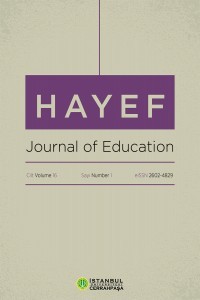Attitudes of Turkish EFL Learners Towards the Use of Drama Activities in English
drama tekniği, İngilizce dil yetisi, konuşma yeterliliği, rol oynama, tutum ve işbirlik
Attitudes of Turkish EFL Learners Towards the Use of Drama Activities in English
drama techniques, English language skill, oral language proficiency, role play, attitude and cooperation,
___
- Adolph, K. E., & S. E. Berger. (2005). Physical and motor development. In M. H. Bornstein and M. E. Lamb (Eds.), Developmental science: An advanced textbook (5th ed.) (pp. 161- 213). Hillsdale, NJ: Lawrence Erlbaum Associates.
- Aldavero, V. A. (2008). Drama in the development of oral spontaneous communication. Encuentro, 17, 40-43. Retrieved April 12, 2015, from http://www.encuentrojournal.org/textos/alonso.pdf
- Alhmali, J. (2007). Student attitudes in the context of the curriculum in Libyan education in middle and high schools. (PhD Thesis, University of Glasgow, Scotland).
- Al-Zahrani, M. (2008). Saudi secondary school male students’ attitudes towards English: An exploratory study. J. King Saudi University, Language and translation, 20, 25-39.
- Ananda, S. (2000). Equipped for the future assessment report: How instructors can support adult learners through performance-based assessment. Washington DC: National Institute for Literacy.
- Baker, C. (1992). Attitudes and language. Clevedon, England: Multilingual Matters.
- Baturay, M. H., & Özbek, G. (2009). Bilgisayar kullanımı etiği ve sağlığı eğitiminin ilköğretim öğrencilerine drama yöntemi ile verilmesi. E-journal of New World Sciences Academy, 4(3), 707- 714.
- Donmoyer, R. (1991). The first glamourizer of thought: Theoretical and autobiographical ruminations on drama and education. In G. Willis & W. H. Schubert (Eds.), Reflections from the heart of educational inquiry: Understanding curriculum and teaching through the arts. New York: State University of New York Press.
- Ellis, R. (1984). Classroom second language development. Oxford: Pergamon.
- Gardner, R. (1985). Social psychology and second language learning. The role of attitudes and motivation. London: Edward Arnold.
- Ghazali, S., Setia, R., Muthusamy, C., & Jusoff, K. (2009). ESL students’ attitude towards texts and teaching methods used in literature classes. English Language Teaching, 2(4), 51-56. Retrieved August 10, 2011, from http://www.ccsenet.org/journal/index.php/elt/article/viewFile/4445/3786
- Huebner, D. (1975). Curriculum language and classroom meanings. In W. Pinar (Ed.), Curriculum theorizing: The reconceptualists (pp. 237-249). Berkley, CA: McCutchan.
- Iamphitakporn, R. (2002). The comparison of English speaking achievement between dramatic activities and non-dramatic teaching for first year accountancy students at Nakhonpathom Technology. (Master Thesis, Graduate School of Silapakorn University).
- Krashen, S. (1982). Principles and practice in second language acquisition. Oxford: Pergamon Press.
- Mackey, A. (1999). Input, interaction, and second language development (An empirical study of question formation in ESL). Studies in Second Language Acquisition, 21(4). Retrieved from http://journals.cambridge.org/action/displayAbstract?fromPage=online&aid=36661&fileId=S0272263199004027
- Maley, A., & Duff, A. (2001). Drama Techniques. A resource book of communication activities for language teachers. Cambridge: Cambridge University Press.
- Maranon, S. (1981). A descriptive analysis of a program of creative dramatics with a bilingual/bicultural content (Spanish/English): Implications for English oral language development.
- Miles, M. B., & Huberman, A. M. (1994). Qualitative data analysis: An expanded sourcebook. Thousand Oaks: Sage Publications.
- Mosher, R. C. (2001). Listening as literacy: Children sounding out text. Journal of Curriculum Theorizing, 17, 91-100.
- Pacyga, J. (2009). Affecting L2 Attitude and motivation through drama. (M.A. Dissertation, Hamline University, St. Paul, MN).
- Patton, M. Q., & Patton, M. Q. (2002). Qualitative research and evaluation methods. Thousand Oaks, Calif: Sage Publications.
- Peregoy, S., & Boyle, O. (2008). Reading, writing, and learning in ESL (5th ed.). Boston: Pearson.
- Reid, N. (2003). Getting started in pedagogical research in the physical sciences. Hull: LTSN Physical Sciences Centre, University of Hull. Retrieved August 9, 2011, from http://hlst.ltsn.ac.uk/assets/ps/documents/practice_guides/ps0076_getting_sarted_in_pedagogic_research_in_the_physical_sciences_aug_2004.pdf
- Ridel, S. P. (1975). An investigation of the effects of creative dramatics on ninth grade students. Dissertation Abstracts International 36 (December 1975): 355-A.
- San, I. (1998). The development of drama in education in Turkey. Research in Drama Education, 3(1), 96-99.
- Visser, M. (2008). Learning under conditions of hierarchy and discipline: The case of the German army (1939- 1940). Learning Inquiry, 2, 127-137.
- Yin, R. K. (1984). Case study research: Design and methods. Beverly Hills, Calif: Sage Publications.
- Başlangıç: 2004
- Yayıncı: İstanbul Üniversitesi-Cerrahpaşa
Attitudes of Turkish EFL Learners Towards the Use of Drama Activities in English
Güneş YILMAZ, Yeşim KEŞLİ DOLLAR
An Investigation into the Experiences of Erasmus Students
Türkiye'de Suriyeli Öğrencilerin Eğitimine Yönelik Okul Yöneticilerinin Görüşleri
3 Boyutlu Dijital Ortamda İngilizce Eğitimi
İlişki Ağı Envanteri Kısa Formu’nun Türkçe Uyarlama Çalışması
Meltem ASLAN GÖRDESLİ, Ayşe Esra İŞMEN GAZİOĞLU
Duygu YAVUZ, Fatma Gülay KIRBAŞLAR
